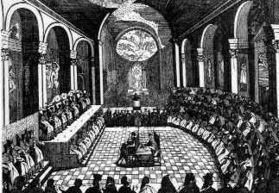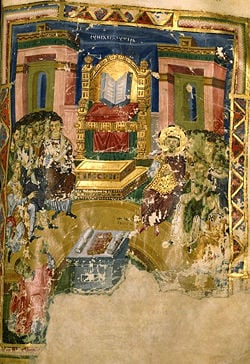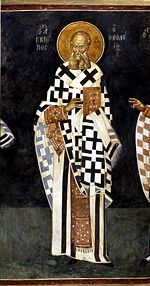First Council of Constantinople
| First Council of Constantinople | |
|---|---|
| Date | 381 |
| Accepted by | Roman Catholicism Eastern Orthodoxy Oriental Orthodoxy Assyrian Church of the East Anglicanism Lutheranism |
| Previous council | First Council of Nicaea |
| Next council | Council of Ephesus |
| Convoked by | Emperor Theodosius I |
| Presided by | Timothy of Alexandria, Meletius of Antioch, Gregory Nazianzus, and Nectarius of Constantinople |
| Attendance | 150 (no representation of Western Church) |
| Topics of discussion | Arianism, Apollinarism, Sabellianism, Holy Spirit, successor to Meletius |
| Documents and statements | Nicene Creed of 381, seven canons (three disputed) |
| Chronological list of Ecumenical councils | |
The First Council of Constantinople is believed to be the Second Ecumenical Council by the Assyrian Church of the East, the Oriental Orthodox, the Eastern Orthodox, the Roman Catholics, the Old Catholics, and a number of other Western Christian groups. This being the first Ecumenical Council held in Constantinople, it was called by Theodosius I in 381[1][2] which confirmed the Nicene Creed and dealt with other matters such as Arian controversy. The council took place in the church of Hagia Irene from May to July 381.
Background
The Council of Nicaea did not end the Arian controversy which it had been called to clarify. By 327, Emperor Constantine I had begun to regret the decisions that had been made at the Nicene Council. He granted amnesty to the Arian leaders and exiled Athanasius because of Eusebius of Nicomedia. Even during numerous exiles, Athanasius continued to be a vigorous defender of Nicene Christianity against Arianism. The Cappadocian Fathers also took up the torch, their Trinitarian discourse was influential in the council at Constantinople.
Up until about 360, theological debates mainly dealt with the Divinity of Jesus, the 2nd person of the Trinity. However, because the Council of Nicaea had not clarified the divinity of the Holy Spirit, the 3rd person of the Trinity, it became a topic of debate. The Macedonians denied the divinity of the Holy Spirit. This was also known as Pneumatomachianism.
The proceedings
Timothy of Alexandria, Meletius of Antioch, Gregory Nazianzus, and Archbishop Nectarius of Constantinople successively presided. Gregory Nazianzus was appointed Archbishop of Constantinople, but soon resigned from the position a few months later, and Nectarius was then put in his place.
The council affirmed the original Nicene creed of faith as true and an accurate explanation of Scripture. This council also developed a statement of faith which included the language of Nicaea, but expanded the discussion on the Holy Spirit to combat the heresy of the Pneumatomachi. It is called the Nicene Creed of 381 and was a commentary on the original Nicene formula. It expanded the third article of the creed dealing with the Holy Spirit, as well as some other changes. About the Holy Spirit the article of faith said he is "the Lord, the Giver of Life, Who proceeds from the Father, With the Father and the Son he is worshipped and glorified." The statement of proceeding from the Father is seen as significant because it established that the Holy Spirit must be of the same being (ousia) as God the Father.
This Council's decision regarding the Holy Spirit also gave official endorsement to the concept of the Trinity. By the end of the 4th century, the Byzantine Emperor Theodosius "issued a decree that the doctrine of the Trinity was to be the official state religion and that all subjects shall adhere to it" (See "Constantine, the first Christian emperor," Antiquity Online)
Seven canons, four of these doctrinal canons and three disciplinary canons, are attributed to the Council and accepted by both the Eastern Orthodox Church and the Oriental Orthodox Churches; the Roman Catholic Church accepts only the first four[3].
The first canon[4] is an important dogmatic condemnation of all shades of Arianism, also of Macedonianism and Apollinarianism.
The second canon[5] renews the Nicene legislation imposing upon the bishops the observance of diocesan and patriarchal limits.
| Part of a series on the Catholic Ecumenical Councils | |

| |
| Councils in Antiquity | |
|---|---|
|
Nicaea I • Constantinople I • Ephesus | |
| Papal Councils during the Middle Ages | |
|
Lateran I •
Lateran II | |
| Councilarism | |
|
Constance • Basel •
Lateran V | |
| Modern Councils | |
|
Council of Trent | |
| General Articles
Ecumenical Councils of the Catholic Church | |
The famous third canon reads:
- The Bishop of Constantinople, however, shall have the prerogative of honour after the Bishop of Rome because Constantinople is New Rome.[6]
This canon was a first step in the rising importance of the new imperial capital, just fifty years old, and was notable in that it demoted the patriarchs of Antioch and Alexandria. Jerusalem, as the site of the first Church, retained its place of honor. By 451, in the Council of Chalcedon (Canon IX), Constantinople would be recognized as the ecumenical jurisdiction of highest ecclesiastical appeal.[7]
Baronius maintained the non-authenticity of the third canon, while some medieval Greeks maintained that it did not declare supremacy of the Bishop of Rome, but the primacy; "the first among equals," similar to how they today view the Bishop of Constantinople. Throughout the next several centuries, the Western Church asserted that the Bishop of Rome had supreme authority, and by the time of the Great Schism the Roman Catholic Church based its claim to supremacy on the succession of St. Peter. When the First Council of Constantinople was approved, Rome protested the diminished honor to be afforded the bishops of Antioch and Alexandria. The status of these Eastern patriarchs would be brought up again by the Papal Legates at the Council of Chalcedon. Pope Leo the Great[8], declared that this canon had never been submitted to Rome and that their lessened honor was a violation of the Nicene order. At the repudiated Fourth Council of Constantinople (869), the Roman legates[9] asserted the place of the bishop of Rome's honor over the bishop of Constantinople's; nine years later, this latrocinium council was replaced.
After the Great Schism (1054), in 1215 at the Fourth Lateran Council[10], Roman supremacy over the whole world was formally claimed by the new Latin patriarch. The Roman correctores of Gratian[11], insert the words: "canon hic ex iis est quos apostolica Romana sedes a principio et longo post tempore non recipit."
The fourth canon[12] declares invalid the consecration of Maximus of Constantinople, the Cynic philosopher and rival of Gregory of Nazianzus, as Bishop of Constantinople.
The fifth canon[13] might have been passed the next year, 382, and is in regard to a Tome of the Western bishops, perhaps that of Pope Damasus I.
The sixth canon[14] might belong to the year 382 as well and was passed at the Quinisext Council as #95 and limits the ability to accuse bishops of wrongdoing.
The seventh canon[15] regards procedures for receiving certain heretics into the church.
Pope Damasus I was not invited (or declined to attend), thus sometimes this council is called the unecumenical council. However, it was affirmed as ecumenical at the Council of Chalcedon in 451.
Aftermath
This council condemned Arianism and it began to die out with more condemnations at a council by Ambrose of Milan in 381. With the discussion of Trinitarian doctrine now developed and well under agreement to orthodox and Biblical understanding, it led to Christology. Christology would be the topic of the Council of Ephesus of 431 and the Council of Chalcedon of 451.
The 150 individuals at the council are commemorated in the Calendar of saints of the Armenian Apostolic Church on February 17.
Notes
- ↑ Socrates Scholasticus, Church History, book 5, chapters 8 & 11, puts the council in the same year as the revolt of Magnus Maximus and death of Gratian.
- ↑ Heather and Matthews, Goths in the Fourth Century, p. 136.
- ↑ NPNF2-14. The Seven Ecumenical Councils | Christian Classics Ethereal Library
- ↑ NPNF2-14. The Seven Ecumenical Councils | Christian Classics Ethereal Library
- ↑ NPNF2-14. The Seven Ecumenical Councils | Christian Classics Ethereal Library
- ↑ NPNF2-14. Canon III, First Council of Constantinople, The Seven Ecumenical Councils | Christian Classics Ethereal Library
- ↑ The Seven Ecumenical Councils | Christian Classics Ethereal Library
- ↑ Ep. cvi in P.L., LIV, 1003, 1005.
- ↑ J. D. Mansi, XVI, 174.
- ↑ op. cit., XXII, 991.
- ↑ (1582), at dist. xxii, c. 3.
- ↑ NPNF2-14. The Seven Ecumenical Councils | Christian Classics Ethereal Library
- ↑ NPNF2-14. The Seven Ecumenical Councils | Christian Classics Ethereal Library
- ↑ NPNF2-14. The Seven Ecumenical Councils | Christian Classics Ethereal Library
- ↑ NPNF2-14. The Seven Ecumenical Councils | Christian Classics Ethereal Library
ReferencesISBN links support NWE through referral fees
External links
- Catholic Encyclopedia: First Council of Constantinople
- Council of Constantinople
- Council of Constantinople
- The Creed from the Council in Greek and English side by side. (Precedence of the bishop of Rome is not mentioned.)
| ||||||||||||||
| |||||||||||||||||||||||||||||||||||
| |||||||||||||||||||||||||||||||||||||||||
Credits
New World Encyclopedia writers and editors rewrote and completed the Wikipedia article in accordance with New World Encyclopedia standards. This article abides by terms of the Creative Commons CC-by-sa 3.0 License (CC-by-sa), which may be used and disseminated with proper attribution. Credit is due under the terms of this license that can reference both the New World Encyclopedia contributors and the selfless volunteer contributors of the Wikimedia Foundation. To cite this article click here for a list of acceptable citing formats.The history of earlier contributions by wikipedians is accessible to researchers here:
The history of this article since it was imported to New World Encyclopedia:
Note: Some restrictions may apply to use of individual images which are separately licensed.


